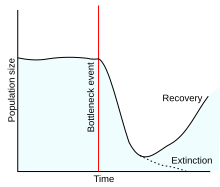
A population bottleneck or genetic bottleneck is a sharp reduction in the size of a population due to environmental events such as famines, earthquakes, floods, fires, disease, and droughts; or human activities such as genocide, speciocide, widespread violence or intentional culling. Such events can reduce the variation in the gene pool of a population; thereafter, a smaller population, with a smaller genetic diversity, remains to pass on genes to future generations of offspring. Genetic diversity remains lower, increasing only when gene flow from another population occurs or very slowly increasing with time as random mutations occur.[1][self-published source] This results in a reduction in the robustness of the population and in its ability to adapt to and survive selecting environmental changes, such as climate change or a shift in available resources.[2] Alternatively, if survivors of the bottleneck are the individuals with the greatest genetic fitness, the frequency of the fitter genes within the gene pool is increased, while the pool itself is reduced.
The genetic drift caused by a population bottleneck can change the proportional random distribution of alleles and even lead to loss of alleles. The chances of inbreeding and genetic homogeneity can increase, possibly leading to inbreeding depression. Smaller population size can also cause deleterious mutations to accumulate.[3]
Population bottlenecks play an important role in conservation biology (see minimum viable population size) and in the context of agriculture (biological and pest control).[4]
- ^ William R. Catton, Jr. "Bottleneck: Humanity's Impending Impasse" Xlibris Corporation, 2009. 290 pp. ISBN 978-1-4415-2241-2[page needed][self-published source]
- ^ Lande, R. (1988). "Genetics and demography in biological conservation". Science. 241 (4872): 1455–1460. Bibcode:1988Sci...241.1455L. doi:10.1126/science.3420403. PMID 3420403.
- ^ Lynch, M.; Conery, J.; Burger, R. (1995). "Mutation accumulation and the extinction of small populations". The American Naturalist. 146 (4): 489–518. doi:10.1086/285812. S2CID 14762497.
- ^ Hufbauer RA, Bogdanowicz SM, Harrison RG (February 2004). "The population genetics of a biological control introduction: mitochondrial DNA and microsatellie variation in native and introduced populations of Aphidus ervi, a parasitoid wasp". Molecular Ecology. 13 (2): 337–48. Bibcode:2004MolEc..13..337H. doi:10.1046/j.1365-294X.2003.02084.x. PMID 14717891. S2CID 45796650.